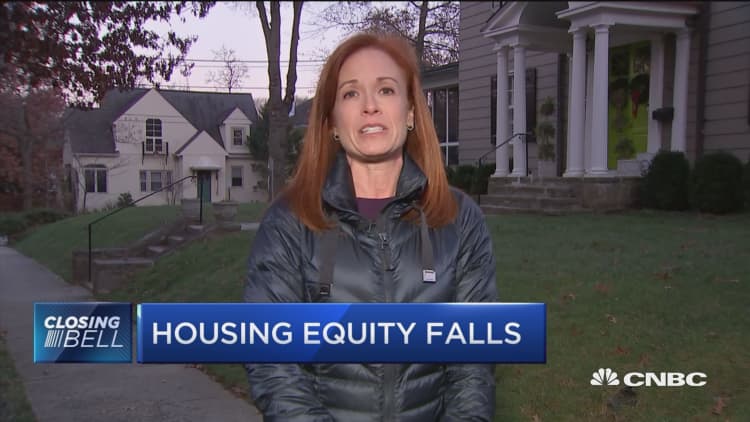
Homeowners in most places are still seeing their nest eggs get a little bigger, but the gains are shrinking quickly.
The average homeowner with a mortgage saw a gain of $12,400 in home equity between the third quarter of last year and this year, according to CoreLogic. That includes price appreciation and paying down the mortgage. That is down from $16,000 in annual gains in the second quarter, and the smallest gain in two years.
States in the West did see bigger gains: Home equity increased by $36,500 in California and by $32,600 in Nevada. Home equity actually fell in North Dakota, Louisiana and Connecticut.
"On average, homeowners saw their home equity increase again this quarter but not nearly as much as in previous quarters," said Frank Nothaft, chief economist at CoreLogic. "This lower year-over-year gain reflects the slowing in appreciation we've seen in the CoreLogic Home Price Index."
Home values were up 5.4 percent annually in October, according to CoreLogic, but they had been gaining close to 7 percent a few years ago and only recently have the gains been slowing more dramatically.
Prices initially ran up quickly because there was so much demand and so little supply. Bidding wars were the norm, especially on the lower end of the market. But as mortgage rates began to rise at the start of this year, potential buyers began to drop out. Affordability hit a decade low.
By summer, values were cooling, and then rates rose again in September. In addition, more homes began coming on the market, and competition chilled as well.
The drop in equity gains has been sharpest in the third quarter of this year. In fact, after hitting a record high, the amount of tappable equity, which is how much cash homeowners can pull out of their homes, fell quarter to quarter for the first time since the housing recovery began, according to Black Knight.
About a quarter of a million fewer homeowners have equity to tap. (Tappable equity is the appraised value of a home minus the 20 percent equity most lenders require for a refinance.)
At the end of the third quarter, 43.6 million homeowners with mortgages had equity available to draw — about 272,000 fewer than in the second quarter. The average homeowner had $136,000 available, which was about $2,300 less than in the second quarter. Equity is still higher, however, compared with a year ago.
Affordability concerns having an impact
"There is still $9.8 trillion in total home equity in the market, some $5.9 trillion of which is tappable. That's $571 billion more than in Q3 2017, and tappable equity remains near an all-time high," said Ben Graboske, executive vice president of Black Knight's Data & Analytics division.
He noted that third quarters are generally flat as far as home prices are concerned, and that tappable equity is up on an annual basis in 98 percent of major metro areas.
"But the fact remains that affordability concerns are beginning to have an impact on home prices, particularly in more expensive markets, and as a result, on homeowner equity as well," Graboske added.
California accounted for nearly 75 percent of the decline in tappable equity, as home values there actually fell quarter to quarter. Just four cities — San Jose, California, San Francisco, Los Angeles and Seattle — made up two-thirds of the net reduction in tappable equity, according to Black Knight's report.
All of those areas saw much greater home price appreciation than the rest of the nation and drove the record amounts of overall tappable equity. Those same markets saw home values fall quarter to quarter.
Not surprisingly, fewer borrowers took equity out of their homes in the third quarter, either through home equity lines of credit or cash-out refinances, according to Black Knight. Just $64 billion in equity was withdrawn, which is down 8 percent from the second quarter and down 10 percent from a year ago.
The third quarter is usually the most popular time for equity withdrawals. Also, the amount of the equity withdraw, just 1.06 percent of all available equity, was near the lowest on record.


